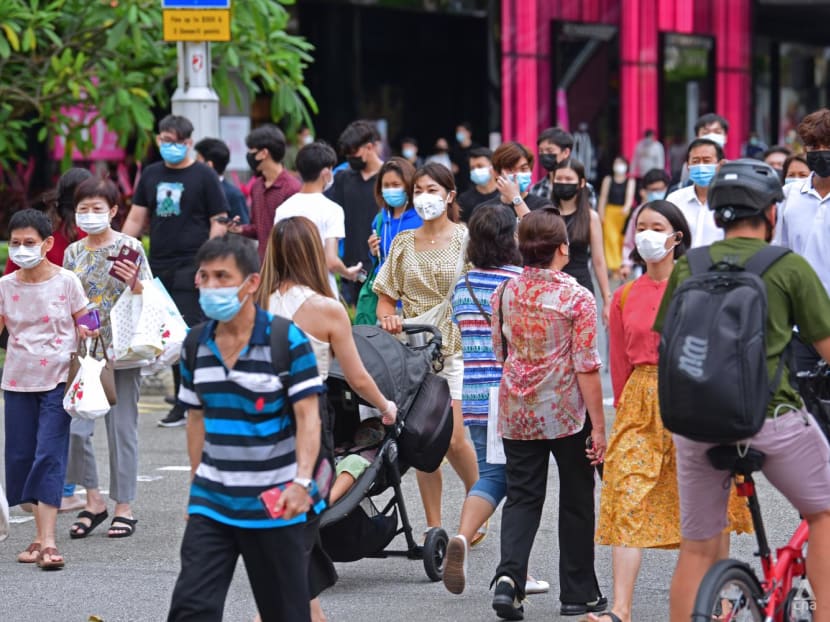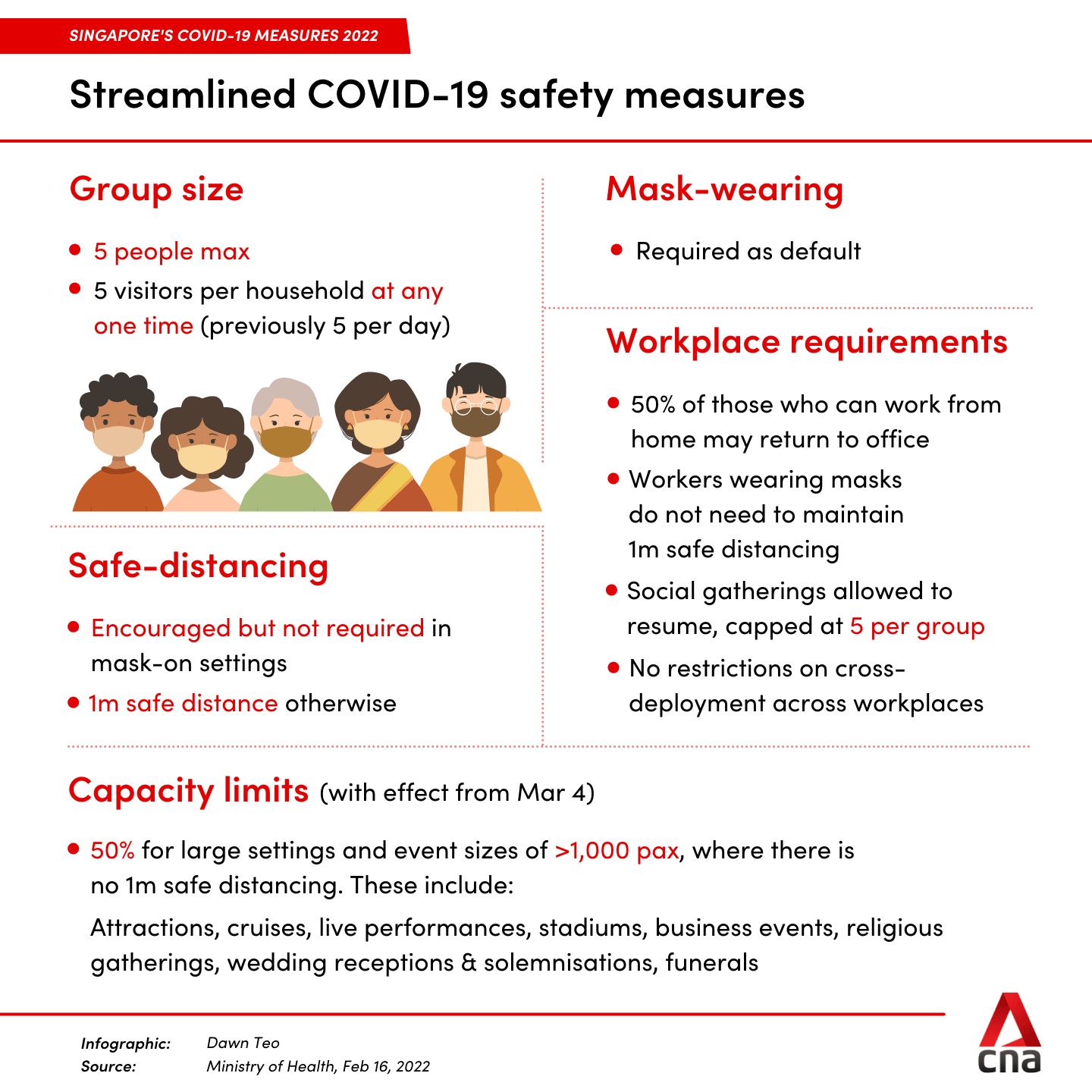Singapore to simplify COVID-19 rules; safe distancing no longer required when wearing masks

People wearing protective face masks in Orchard in Singapore on Jan 5, 2022. (File photo: CNA/Gaya Chandramohan)
SINGAPORE: Singapore will simplify its COVID-19 rules and do away with the requirement for safe distancing in mask-on settings, the multi-ministry task force announced on Wednesday (Feb 16).
The streamlined rules, which will apply from Feb 25, will focus on the five “most important and effective measures” – group sizes, mask-wearing, workplace requirements, safe distancing and capacity limits.
Speaking at a task force press conference, co-chair Gan Kim Yong said safe-management measures are being simplified so that they are easier for businesses and people to understand and comply with.
"This will also encourage a greater sense of personal responsibility, which will play an increasingly important part in our journey towards COVID resilience,” he said.
Singapore's new COVID-19 cases are likely to remain at between 15,000 and 20,000 or even higher a day, said Mr Gan. But cases are expected to peak in a few weeks.
When the number of cases begins to fall, Singapore can then further ease its COVID-19 measures, he added.
“In the meantime, we will streamline and rationalise our border measures, healthcare protocols and safe-management measures, to prepare ourselves for reopening after the Omicron wave subsides.”
“These five parameters crystalise what we learnt to be the most important aspects of SMMs (safe-management measures) for pandemic control,” said Health Minister and task force co-chair Ong Ye Kung.
Although they do not represent a relaxation of the rules, there are “quite profound implications” on the way Singapore manages the COVID-19 pandemic.
If a new variant of concern emerges, authorities will try to adjust these five measures "instead of coming up with micro rules for different settings" which add on to a "confusing web of regulations", said Mr Ong.
Related:

SOCIAL GATHERINGS LIMIT REMAINS AT FIVE PEOPLE
From Feb 25, safe distancing is encouraged but will not be required between people or groups while wearing masks, said the Ministry of Health (MOH) in a separate press release.
Safe distancing will still be mandatory when not wearing masks, and the required distance will be fixed at 1m for all settings.
The group size limit for social gatherings remains at five people. But the maximum number of unique visitors per household will be adjusted from five people per day to five people at any one time.
Wearing a mask will continue to be the default, the ministry said, adding that “there are no new exceptions”.
For workplaces, 50 per cent of employees who can work from home will continue to be allowed back at the office.
But with safe-management measures streamlined, workplace requirements will now be “aligned” with those in the community, the Health Ministry said.
For example, employees who have their masks on will not have to maintain 1m safe distancing in the workplace. Social gatherings at the workplaces will also be allowed to resume with up to five people in a group.
“There will be no restrictions on cross-deployment of employees across workplaces, although employers may continue to do so for business continuity reasons,” MOH added.
EVENT SIZES BASED ON VENUE CAPACITY
From Mar 4, specific size limits for events like religious services, wedding receptions, business events, media conferences, funerary memorial events and mask-on classes will be lifted.
Instead of fixed size limits for different types of events, MOH will set event sizes based on the capacity of the venue. Zoning requirements will also be removed, because the “main protection” is through masks and vaccinations, the ministry said.
However, for large events and settings that pose more infection risks, capacity limits will still be imposed. These include attractions, cruises, MICE and large work-related events, as well as large performing arts venues or sports stadiums.
For other settings like shopping malls and large standalone stores, the current density limit is at about 50 per cent capacity. The threshold will be set at 1,000 people for now, said MOH in the press release.
This means that smaller events or settings with 1,000 people or fewer can proceed without any capacity limits, while larger settings or events with more than 1,000 people will be subject to a capacity limit of 50 per cent.
All mask-off events will have to comply with the 1m safe-distancing distance.
With the new rules, practices that “actually do not make a material difference” to the pandemic are no longer forbidden, said Mr Ong.
“For example, so long as people are wearing masks, there is no need to cross out alternate seats in park benches, or the urinals in a men’s toilet. Or when people wear their masks and they stand together and take a photo they don’t have to be a metre apart,” he added.
“I think all these little things don’t matter, really don’t matter anymore, we can do away with them. Our people know that we are in a crisis and we can start to remove these little daily reminders that are not really material anymore.”
Two years of safe-management measures have “taken a toll” on the physical and mental well-being of people, especially on those who are young, he said.
The Health Ministry also announced some adjustments to vaccination-differentiated safe-management measures.
From Feb 25, unvaccinated children aged 12 and below do not need to be from the same household to be included in a group entering a place or participating in activities with vaccination-differentiated measures.
All sports will be allowed to proceed with up to 30 fully vaccinated people at supervised or operated sports facilities.
Prevailing safe-management measures will apply before and after the activity and during rest breaks, the ministry said. No additional testing requirements will be imposed as long as all participants are fully vaccinated, but participants are encouraged to test themselves in advance.
“The main driver of COVID-19 transmission is prolonged and close contact by eating together in an enclosed space. Sports on the other hand, while you’re playing, involves transient contact between players on the field or on the court,” said Mr Ong.
“Hence, there’s been no compelling international evidence showing that sports participation causes more infections. You are more likely to catch the virus dining with friends than playing sports with them.”
GATHERING SIZES COULD "GO UP TO 8 OR 10"
Beyond the five key measures, there are a few other specific rules that were designed to address higher-risk activities, including those around singing, alcohol consumption at F&B outlets and nightlife activities, said co-chair Lawrence Wong.
“For now, we will not make changes to these rules, but over time as we adjust our overall posture around the five key parameters, we will also be reviewing and updating these specific rules for the settings which I have just described,” he added.
If things remain “well under control”, Singapore can take further significant steps to ease measures after the peak of the Omicron wave passes, which may happen in the coming weeks, said Mr Wong.
“And at that time, we will be able to make a decisive move to ease across these five key parameters, which means group size, we can potentially go up to eight or 10. Capacity limits could go up from 50 per cent to 75 per cent. Work from home requirements, we may have more people being allowed to go back to the office from 50 per cent to 75 per cent, and so on.”
Stressing that the streamlining of the rules is not an easing of measures, Mr Wong added that “it’s not the time for easing” because Singapore is still seeing rising COVID-19 case numbers.
“But we are quietly confident in facing this Omicron wave, because everyone in Singapore is well-protected with vaccination and boosters, and … the vast majority of people who get infected are not so ill, so the numbers needing oxygen or ICU care remain manageable and things are generally well under control.”
BOOKMARK THIS: Our comprehensive coverage of the COVID-19 pandemic and its developments
Download our app or subscribe to our Telegram channel for the latest updates on the coronavirus pandemic: https://cna.asia/telegram










